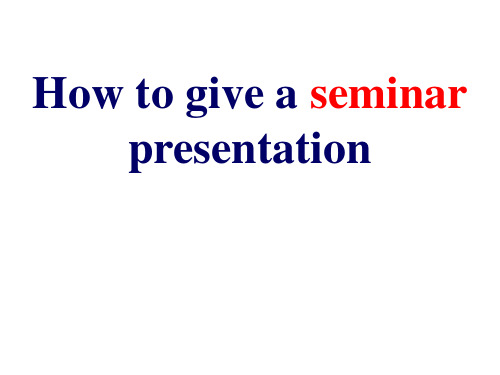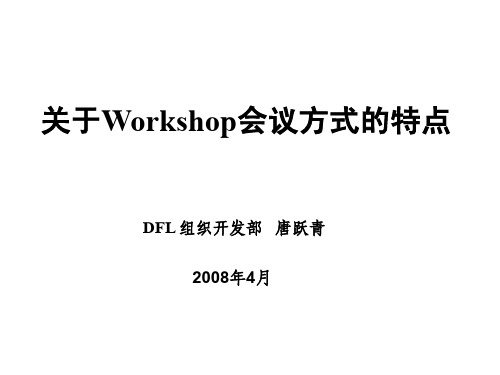difference_workshop_vs_seminar
- 格式:pdf
- 大小:20.68 KB
- 文档页数:3


seminar ap 考试内容
AP seminar的考试内容主要包括以下几个方面:
1. 团队项目和陈述:这是AP seminar考试中的重要部分,占总体分数的25%。
在这个部分,学生需要完成一个团队项目并进行报告。
项目通常是由3~6名学生组成的团队进行,学生需要确定他们想要研究的问题。
每个学生都需要单独进行自己的研究,并在小组内展示他们的发现和研究结果。
然后,小组成员共同完成一份书面报告以及课堂陈述,为自己的论点进行辩护。
这个部分是基于老师提出的具体问题。
2. 基于个人研究的论文和陈述:这个部分占AP seminar 分数的35%,其中包含一份两千字的个人书面论证和6~8分钟的个人多媒体演示及口头答辩。
3. AP考试:考试时间为两个小时,包括理解和分析一个论文(三个简答题)、循证论证短文(一篇长短文),占ap研讨会分数的45%。
此外,AP seminar的期末考试内容还涉及论证、主要思想或论文、解释推理路线、评估证据的有效性等方面的考核。


研讨会英语单词在当今全球化的背景下,研讨会成为了交流和合作的重要方式,而在参与研讨会时,熟练掌握一定的英语单词表达是至关重要的。
本文将介绍一些常用于研讨会中的英语单词,帮助读者扩展词汇量,提升研讨会表达能力。
术语表达•Presentation:演讲•Seminar:研讨会•Workshop:讲习班•Keynote speech:主题演讲•Panel discussion:座谈会•Q&A session:问答环节•Breakout session:分组讨论交流表达•Introduce:介绍•Discuss:讨论•Share:分享•Agree:同意•Disagree:不同意•Summarize:总结•Clarify:澄清•Elaborate:详细阐述•Raise a point:提出一个观点提问表达•Ask a question:提问•Could you elaborate on that?:你能详细阐述一下吗?•What’s your opinion on this matter?:你对这个问题有什么看法?•Could you give us some examples?:你能给我们举几个例子吗?•Do you have any data to support your argument?:你有数据支持你的观点吗?•Could you explain it in simpler terms?:你能用简单的词语解释一下吗?结语通过学习和掌握这些研讨会英语单词,我们可以更加流利地表达自己的意见,更好地参与到研讨会中。
在未来的研讨会中,让我们充分利用这些单词,展现出自信和专业的形象。


英国大学课堂三种教育模式及注意事项区别于中国的教育,英国的课堂模式和中国并不相同,为了减少同学们去到英国后的不适应,小编整理了这些干货分享给你们。
英国大学课堂教学模式主要有三种,分别是:Lectures、Seminars、Tutorials。
根据不同大学,不同学科以及不同老师之间可能在这三方面有所侧重。
LecturesLectures就是普通教学模式,老师会用PPT/教学工具等等演示每一堂课的重点。
而比较重要的是,相应的每一堂Lectures之后(或者在上课的时候)都会有一个讨论的课程(或者部分)叫Seminars(一些学校也会叫作Classes/Meeting/Discussion)。
Seminars上,一般来说是有一个老师(Tutor)来把握方向,引导同学们的讨论。
SeminarsSeminars的目的就是对Lecture讲授的内容和阅读列表的主题进行提问和讨论,所以每个学生都必须要在讨论环节上发表自己的看法和观点。
这是一个思想碰撞的过程,你会发现各种看问题的角度。
TutorialsTutorials是一种小班模式,主要的目的就在于解答同学们的提问,通常人数不会太多(1-4个学生左右)。
一般来说都是老师师安排的,通常一周一次。
建议最好不要错过了。
Tutorials之前你可能会收到一个Reading List(按照学科不同而有区别),Reading List可能是某本书里面的某个章节,也可能是某个学术杂志期刊,甚至可能是一段Video或者Radio。
你得自己判断这里面哪一部分可以用在你的论题上。
英国大学课堂大致上就是这样。
按照以往大家的通关经验,Seminars是小Boss中最难打的一个,并且一般容易被打脸。
1. 国内国外的教学方式差别很大。
大家已经习惯了老师讲我听的模式了,所以在开始的时候会很不习惯开口直接发表自己观点。
2. 不好意思开口,还有不够自信,以及同学们/老师说的英语口音好重听不懂而导致没法加入讨论等等,都会在Seminars中体现得非常明显。
“Seminar”教学法在行政管理专业教学中的应用摘要:“Seminar”教学法在西方发达国家高等教育教学中因其独特的教学方式和价值而得到普遍的应用。
在行政管理专业教学中引入这一模式,对学生研究能力、自学能力与创新能力将起到促进作用,对此应当积极推广并提供相应保障。
标签:seminar;行政管理;教学改革“Seminar”中文音译为“习明纳”、“习明纳尔”或“席明纳”,意译为“研讨班”。
seminar教学模式起源于18世纪的德国,并于19世纪70年代在美国兴起,是西方国家大学本科和研究生教学中非常重要且普遍使用的教学模式。
这种教学模式是围绕某个或某些学生共同感兴趣的问题,让学生单独或以小组形式,经过阅读文献、调查研究、分析讨论、实验操作以及文献资料分析和综合等,获得解决问题的途径,然后写成研究报告,并由某个或某组学生做主题发言,组织全班学生参加讨论,从而培养他们具有相关能力和掌握相关知识。
在行政管理专业的教学中,运用seminar教学模式,可以极大提高学生的主动性和积极性。
一、Seminar教学法对传统教学的改革与创新传统的课堂教学模式是“教师讲、学生听”,在课堂教学中,学生的活动是为了配合教师的教学,留给学生的时间、空间都很少,所以学生极少拥有独立思考、独立解决问题的机会,其结果只能使学生盲目地接受和被动地记忆课本或教师传授的知识,成为一个装载知识的“容器”。
而seminar教学法则注重充分调动学生的自主学习,促进师生互动,要求师生对教学过程进行反思。
首先,seminar教学法以研究问题组织教学,这就有可能促进学生的问题意识,并且这种模式在对问题讨论的基础上要求学生开动脑筋进行判断、思考,这便提高了学生的判断和思考能力,从而促使其思维的进一步发展。
同时,通过调查与研究去探索解决问题的途径,这便帮助学生熟练掌握和应用调查方法、试验方法、统计方法、获取信息和分析信息的技术、比较、论证和归纳的方法,提高了学生分析、批判、综合、描述和报告的能力。
研讨会的英文翻译研讨会的英文翻译英语是一种西日耳曼语支,最早被中世纪的英国使用,并因其广阔的殖民地而成为世界使用面积最广的语言。
以下是店铺帮大家整理的.研讨会的英文翻译,欢迎大家借鉴与参考,希望对大家有所帮助。
seminar参考例句:Workshop; symposium; seminar; forum研讨会In September 2002, China held the ARF seminar on military logistics outsourcing support in Beijing.中国还于2002年9月在北京举办了东盟地区论坛军队后勤保障社会化研讨会。
IDG World Expo (Asia) Ltd. has brought the most successful IDG CEO/CIO Conference,ASPWorld,and BioIT.IDG世展博览(亚洲)有限公司将IDG最成功的展会系列引入亚洲,其中包括CEO/CIO,ASPWorld以及BioIT研讨会等He has presided over a seminar for social psychologists.他主持了社会心理学家的研讨会。
The specialists and scholars present at the symposium come from all corners of the country.出席研讨会的专家学者们来自全国各地。
He'll chair a weekend workshop on politics.他将主持一次周末政治研讨会。
The fee includes seminar materials, certificate of attendance and refreshment.费用包括研讨会资料、证书、茶歇。
Admittedly, these misunderstandings have done little harm outside the historicist workshop.当然,这些误解在历史决定论的研讨会之外是没有什么害处的。
色建筑设计理念包括以下几个方面:1.绿色建筑不等于技术的叠加。
绿色建筑更大的意义不是在于技术在节能发面的体现,而是充分利用自然资源,比如太阳能和自然风。
比如调整一个窗户的方向使得房间里的人可以感受到夏季的风,就不要额外的制冷设施(找例子,百度文库里有)。
建筑设计师在设计建筑时,也要考虑当地的气候条件,从而决定建筑的平面形式和总体布局,最大程度上减少人造资源的使用,达到节能的目的。
比如延安窑洞,充分利用地形,冬暖夏凉。
以黄土高原的窑居为例,无论是土窑或砖石窑,其共同特点是采用拱结构,覆以厚厚的黄土层。
巧妙地利用了当地丰富的太阳能以及黄土的蓄热隔热性能,在外界气温日较差近20摄氏度的情况下,仅需少量辅助能源,就可将室内的温度波幅维持在非常小的波动范围,营造出冬暖夏凉的室内环境。
1.Green building is not equal to the superposition of technology. Green building have more significance in making full use of natural resources, such as solar and natural wind instead of saving power. For example, adjusting the direction of the window can make the people in the room feel the summer wind so that you do not need additional refrigeration facilities. We archtectects should consider the local climate conditions to decide the plane of architecture form and the overall layout in order to reduce the use of artificial material to achieve the goal of energy saving. Take the cave house in the loess plateau for example, whether the cave house made by loess or brick,their common characteristic is the arch structure, with thick loess covered . This kind of house make use of the local rich solar and the accumulation of heat insulating performance of the loess.By this way,the cave house can maintain the temperature inside when the range of temperature outside is over 20 degrees.3.回归自然:绿色建筑外部要强调与周边环境相融合,和谐一致、动静互补,做到保护自然生态环境。
The Differences Between a Seminar and a WorkshopBy Suzanne PattersonMany makeup artists often look to take short term training courses, such as seminars and workshops, to advance their skills instead of investing in costly makeup school classes. When looking for educational opportunities to advance your skill set it's important that you understand the structure and instructional differences between a seminar and workshop, and what to expect from each as outlined and explained below.The first thing you need to keep in mind about people coming together to participate in any kind of instructional situation is that each person possesses a learning dominance towards one of three distinct types of teaching styles, or modalities, that they lean towards the most: visual, auditory, or manipulative. These are the basics of information transfer, and it simply means some people learn better by seeing, some learn better by hearing, and some learn best with a hands-on experience added into the presentation. The good news is everyone has a combination of all three styles, but an individual will always favor one particular style over the others for learning because of inherent brain patterning.Class Structure:It is important to know your personal dominant style of learning so that you know how to get the most out of your investment. If you are a person that comprehends easily through hearing and watching others do things, such as a lecture with visual demonstration, then you will always do well with a seminar. If you are a person that not only has to hear about it and see it done, but experiment with hands-on in creating it yourself, then a workshop is always a good option.A good seminar or workshop will be constructed in such a way to provide the best learning curve to meet a combination of learning styles adequately in a timely fashion. However, you should always inquire beforehand how the class is actually planned out according to the percentage of lecture, demonstrations, and any hands-on work being presented so you can prepare to get the best possible benefit from the experience. This will help you decide if it meets your dominant style of learning.Functions of a Seminar:This class structure is based on the lecture and demonstration format. This means the instructor has prepared the concepts and techniques they will present and discuss through a combination of visual materials, interactive tools or equipment, and demonstrations. Note taking is always a good thing to do so that you have a form of review once the class is over.This format should always include some take home materials for the student that relates to the lecture and demonstration, and that gives them summary points to review along with their notes. A full laboratory phase (direct student hands-on working opportunity) is not a requirement for this kind of class structure, nor is it necessary in order for the seminar to be considered fully and successfully integrated into the student's educational and skill acquision process. As long as the lectures,demonstrations, visuals, materials/interactive tools are appropriately networkedthroughout the seminar content for full educational impact, a seminar is a complete learning experience. Seminars are often larger classes because there is nolaboratory phase, and the benefit of student questions brought up for discussion always enhances the collective knowledge of the attendees.Functions of a Workshop:This class includes all the elements of the seminar mentioned previously, but with the largest portion being emphasized on student hands-on practice, or "laboratory" work. Workshops are more expensive than seminars to produce because of thetime-intensive labor of preparing and teaching the laboratory phase, along with preparing materials apportioned to each student’s practice. The lab work is designed to reinforce, imprint, and bring forward an immediate functioning dimension to the student's eyes and hands by implementing and practicing the actual concept or technique that was taught through the lecture and demonstration process.The laboratory phase is a very important part of the workshop to establish the newly learned method into real skill performance, by patterning the "brain to eye to hand" in the lab exercises or creative techniques. A crucial factor for student success in a workshop is the student to teacher ratio. It should be small enough so that the instructor can closely monitor, provide oversight, and extra help personally to each student without compromising the day’s agenda. The laboratory element must be a significant phase of the workshop or it risks being an incomplete integration of the knowledge process and skill in technique to the student.It is my strong opinion that the laboratory phase should never be less than ½ of the entire day’s presentation, meaning the student should be spending half of the time in active hands-on work. If the class does contain more lecture and demonstration than lab work then consider that the course might be too restrictive to accomplish satisfactorily for students who do best with hands-on learning.I also believe that the teacher to student ratio in a workshop should never be greater than 6 – 8 students, and if so, there should be professional assistants that have the same knowledge base and ability to provide oversight as the instructor. This is so that the instructor never loses the ability to keep close and personal oversight with each student during the laboratory phase while fulfilling the day’s lesson plan.In my many years of teaching experience I can honestly say that a workshop that exceeds this student to teacher ratio risks more unhappy and unfulfilled student experiences, and negative “word of mouth” feedback about the instructor and the workshop. More than 8 students in a workshop taught by just one instructor significantly changes the dynamics of the learning curve where the instructor can often lose control over the pace. This resorts to more to lecture and demonstration being done than laboratory work as a fail safe mechanism, which ends up shortchanging the students and the day’s agenda.Summary:Always ask questions about the qualifications of the instructor and the day’s agenda of the seminar or workshop you are considering investing in. Make sure you understand how the material will be presented in the ratio of lecture, demonstration,interactive tools, and any hands-on work. If you are attending a workshop makesure you know what the limit is on the class size, and how much of the lesson plan centers on actual laboratory work. Less than half of the time apportioned to hand-onwork is cause to reconsider if this is more of a “blended” seminar with a laboratory phase tacked on. Consider the track record and word of mouth feedback by talking to others who have had first hand attendance in the class you are considering, as happy customers are generally a good indicator of the success of the course. Workshops and seminars can be a valuable training asset and experience if you know how to choose wisely for your investment.Copyright © Creative Artistry & FX。